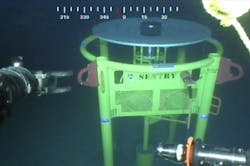Leak detection sonar trial under way in the Gulf of Mexico
Offshore staff
HAMPSHIRE, UK– Sonardyne International Ltd. has deployed a Sentry integrity monitoring sonar (IMS) system in the US Gulf of Mexico for an oil major.
The system has been deployed on the seafloor at more than 2,000 m (6,500 ft) water depth. Sentry IMS, which can be installed short-term or permanently, is said to be able to detect, classify, and localize subsea releases of hydrocarbons from either the seafloor or oil and gas field production infrastructure.
In this latest deployment, the system is being deployed under a six-month trial that will demonstrate its ability to provide real-time subsea asset monitoring. The Sentry sonar head, which is mounted on a seafloor lander, is connected into an existing power and communication umbilical to a floating production facility.
During operation, inbuilt intelligence using algorithms developed by Sonardyne continuously assess the sonar data gathered by Sentry and generate near real-time automatic alerts of any hydrocarbon seeps detected in the water column.
As part of the trial deployment, simulations of an oil plume in the water were created, using nitrile-fiber strands, proving fast and accurate detection and classification of the equivalent release of 100 b/d of oil out to 244 m (800 ft), a distance only constrained by the trial environment. This was achieved within seconds of the simulated leak occurring.
However, the company said Sentry’s capability covers 100 b/d mono-phase oil leaks at distances of up to 740 m (2,427 ft). For mono-phase gas leaks, the system is capable of detecting down to 1 b/d at 500 m (1,640 ft) or 100 b/d (as measured at depth) at 1,000 m (3,280 ft).
03/06/2019
